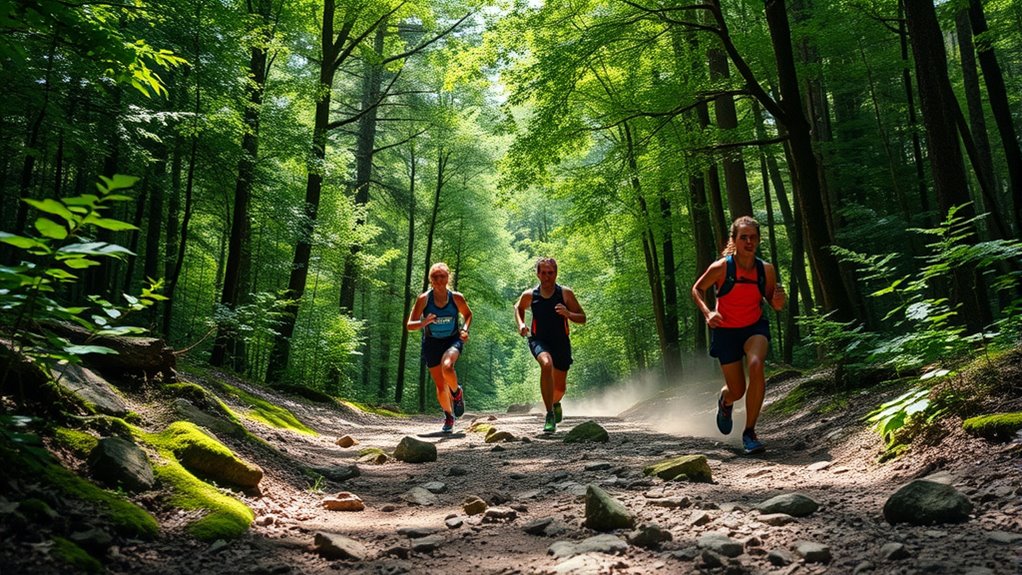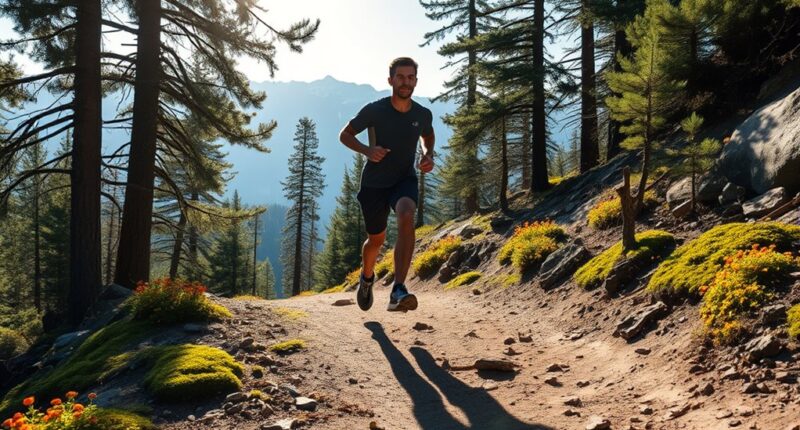You’ve likely noticed trail running’s rapid rise as a sport, driven by the thrill of traversing uneven paths, rocky slopes, and scenic landscapes. It offers a unique challenge that tests your agility, focus, and strength beyond traditional road running. The sport’s growing community embraces outdoor adventure and natural beauty, making each run an engaging experience. Keep exploring, and you’ll discover how this exhilarating sport continues to evolve and inspire more enthusiasts like you.
Key Takeaways
- Increasing popularity due to adventure, nature connection, and emotional well-being benefits.
- Growth of competitive events and organized races worldwide.
- Enhanced focus on specialized training, gear, and hydration strategies.
- Rising media coverage and social media exposure boosting visibility.
- Recognition as a distinct sport with a dedicated community and culture.

Have you ever wondered what makes trail running stand out as a sport? It’s the unique challenge of navigating mountain terrain that sets it apart from traditional running. When you hit the trails, you’re not just running on flat surfaces; you’re tackling uneven paths, rocky inclines, and sometimes muddy slopes. This rugged environment demands more than just speed — it calls for agility, focus, and strength. Every step requires you to adapt quickly, making each run a dynamic test of your physical and mental endurance. Unlike road running, where surfaces are predictable, trail running immerses you in nature’s unpredictable landscape, which keeps you engaged and constantly alert. The mountain terrain also offers breathtaking views and a sense of solitude that you can’t find on city streets, adding an emotional layer to your workout.
However, because of these demanding conditions, managing hydration becomes essential. Trail running through mountain terrain can be intense, often lasting several hours, especially during longer races or adventures. Unlike running on a treadmill or pavement, where water stations are frequent, trail runners need to plan ahead for hydration strategies. You can’t always count on easy access to water, so carrying a hydration pack or bottles is necessary. Proper hydration isn’t just about quenching thirst; it prevents dehydration, preserves your stamina, and helps avoid cramps and fatigue. As you ascend and descend, your body heats up and loses fluids faster, making it vital to sip regularly. Some runners prefer electrolyte drinks to replenish lost minerals, which can be critical in preventing cramping and maintaining muscle function. The key is to develop a hydration plan tailored to your pace, distance, and the specific terrain you’re tackling. Testing different strategies during training helps you find what works best, ensuring you’re fueled and hydrated for the entire run.
Trail running also encourages you to be mindful of your surroundings, which influences your hydration habits. For example, on steeper climbs, you might need to hydrate more frequently, while on flatter sections, you can take a moment to refuel and rehydrate. Proper preparation includes knowing the trail, carrying enough water, and planning your stops accordingly. This awareness not only keeps you safe but also enhances your overall experience. Additionally, understanding the importance of raw food can be beneficial for long-distance trail runners seeking natural nutrition options during extended outings. As you continue to explore mountain terrain, you’ll realize that managing hydration strategies is just as essential as your running technique. It’s a balancing act — pushing your limits while ensuring your body has what it needs to perform at its best. Ultimately, mastering these elements allows you to enjoy trail running’s full potential, connecting deeply with nature and pushing your boundaries in a sport that’s as demanding as it is rewarding.
Frequently Asked Questions
What Are the Most Popular Trail Running Events Worldwide?
You should know that popular trail running events worldwide include the Ultra-Trail du Mont-Blanc, Western States 100, and Ultra-Trail Australia. To excel, focus on trail race strategies like pacing and hydration, and use eco-friendly trail gear to reduce your environmental impact. These events attract runners seeking challenging terrains and scenic views, making them the ultimate tests of endurance and trail running passion.
How Do Trail Runners Train Differently From Road Runners?
Training for trail running is like preparing for an adventure—you need to adapt. You focus on trail running biomechanics, strengthening stabilizer muscles to handle uneven terrain. Your trail running footwear offers extra grip and support, unlike road shoes. You incorporate hill repeats, technical terrain practice, and balance exercises, making your training more varied and dynamic. This approach helps you navigate roots, rocks, and steep inclines safely and efficiently.
What Safety Gear Is Essential for Trail Running?
You should prioritize safety equipment like a hydration pack, trail running accessories such as a headlamp, and a fully charged mobile phone for emergencies. Wear trail-specific shoes with good grip, and carry a small first aid kit. Consider trail markers or GPS devices to avoid getting lost. Always dress appropriately for weather conditions, and carry snacks for energy. These safety essentials will keep you protected and prepared on your trail running adventures.
How Does Trail Running Impact Long-Term Joint Health?
Trail running can be a double-edged sword for your joints. When you focus on joint preservation and injury prevention, you strengthen muscles around your knees and hips, which cushions your joints over time. However, consistently running on uneven terrain without proper technique or gear can lead to joint stress and long-term damage. To protect your joints, listen to your body, stay attentive to form, and incorporate rest days into your routine.
Are There Specific Nutrition Strategies for Trail Running Endurance?
To boost your endurance during trail running, focus on nutrition strategies like using energy gels to quickly replenish carbs and maintain energy levels. Don’t forget hydration strategies—drink regularly to stay hydrated and prevent fatigue. Combine these with electrolyte drinks to replace lost minerals, especially on hot days. Planning your nutrition and hydration in advance helps you sustain your performance and enjoy the trail without hitting a wall.
Conclusion
As trail running gains momentum, it’s clear this sport is more than just a workout—it’s a journey of resilience and passion. You’ll face rugged terrains, push your limits, and discover new heights within yourself. Remember, every mountain top is within reach if you keep climbing. Embrace the challenge, stay determined, and let the trails inspire you to grow stronger, faster, and more connected to nature. After all, the only way out is through.









